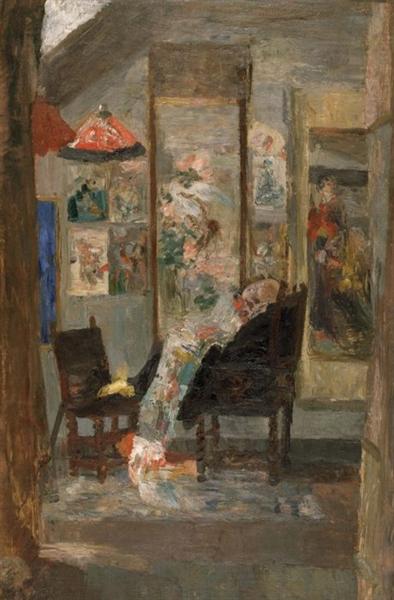Description
The work "Skeleton looking Chinoiseries" by the Belgian painter James Ensor, created in 1885, is an eloquent testimony of his unique artistic vision and his disturbing exploration of life and death. This oil on table not only embodies the lush elements of the style that characterizes it, but also offers a deep comment on the human condition through the representation of the skeleton, a recurring reason in his work. The painting is part of the context of a rise of interest in oriental aesthetics in European art, which is reflected in the reasons and patterns that decorate the background of the composition.
In the work, the skeleton is presented as a central figure, worthy of attention and contemplation, looking towards a world of Chinoiseries that invades the visual space. The skeletal figure, with its defined contours and its almost gray texture, contrasts drastically with the vibrant color palette that characterizes the "Chinoiseries", which present a series of oriental decorative elements encapsulated in intricate patterns. These colors, which vary from saturated red and green tones to the softer blue and yellow, create a dynamism that catches the viewer and reinforces the sense of duality between life and death.
The choice of skeleton as the protagonist in a scene of curiosity in front of the Chinoiseries underlines a feeling of irony. Often, Desor used the figure of death as a way to interrogate the notions of mortality and existence. The skeleton, when observing the oriental decorations, can be interpreted as a symbol of the perception of a world beyond the earthly, a connection between the ephemeral and the eternal. In this way, Ensor invites reflection on how cultures can coexist and dialogue, even in death.
His works, including "skeleton looking Chinoiseries", enroll in the tradition of symbolism and expressionism, standing out for their powerful mixture of the grotesque and the festive. Through its use of color and shape, Ensor evokes a deep emotional response in the viewer, something common in his career. Its inclination towards the use of fantastic and often macabre elements reconfigures the idea of the portrait and nature of art as a means to explore deeper and more universal truths.
The influence of Asian decorative arts was expanding in Europe during the 19th century, and Desor captures this current by integrating these reasons into their work, not only as a decorative element but as a channel to express their philosophical and existential concerns. The fusion of oriental aesthetics with the symbolism of the skeleton integrates cultural reflection with a comment on the fragility of life.
"Skeleton looking Chinoiseries" is among the most intriguing works, showing its ability to combine pictorial technique with the exploration of complex issues. Thus, the painting It becomes a meeting space between the tangible and the intangible, the ephemeral and the eternal, revealing one of the deepest facets of humanity. The work not only faces the inevitable destiny of death, but also invites us to contemplate the beauty and complexity of the world in which we live.
KUADROS ©, a famous paint on your wall.
Hand-made oil painting reproductions, with the quality of professional artists and the distinctive seal of KUADROS ©.
Art reproduction service with satisfaction guarantee. If you are not completely satisfied with the replica of your painting, we refund your money 100%.

